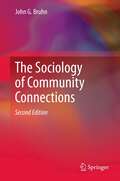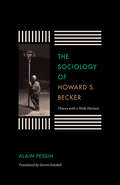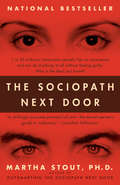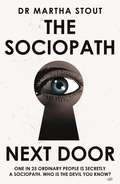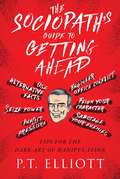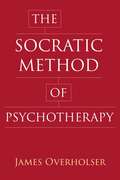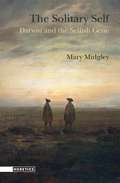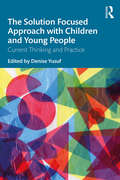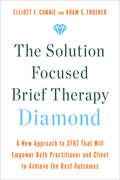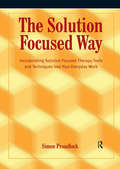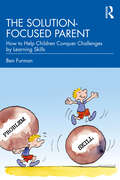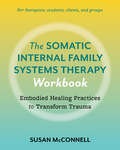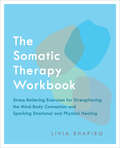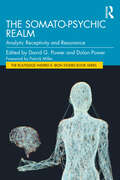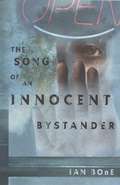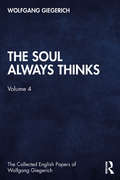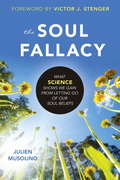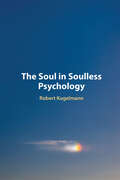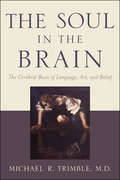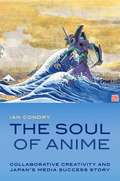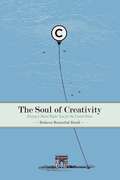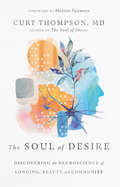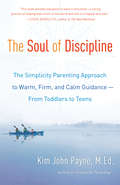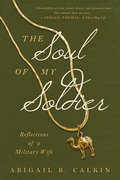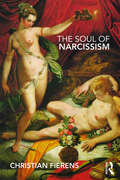- Table View
- List View
The Sociology of Community Connections
by John G. BruhnMany of our current social problems have been attributed to the breakdown or loss of community as a place and to the fragmentation of connections due to an extreme value of individualism in the Western world, particularly in the United States. Not all scholars and researchers agree that individualism and technology are the primary culprits in the loss of community as it existed in the middle decade of the 20th century. Nonetheless, people exist in groups, and connections are vital to their existence and in the daily performance of activities. The second edition of the Sociology of Community Connections will identify and help students understand community connectedness in the present and future.
The Sociology of Howard S. Becker: Theory with a Wide Horizon
by Steven Rendall Alain PessinHoward S. Becker is a name to conjure with on two continents —in the United States and in France. He has enjoyed renown in France for his work in sociology, which in the United States goes back more than fifty years to pathbreaking studies of deviance, professions, sociology of the arts, and a steady stream of books and articles on method. Becker, who lives part of the year in Paris, is by now part of the French intellectual scene, a street-smart jazz pianist and sociologist who offers an answer to the stifling structuralism of Pierre Bourdieu. French fame has brought French analysis, including The Sociology of Howard S. Becker, written by Alain Pessin and translated into English by Steven Rendall. The book is an exploration of Becker’s major works as expressions of the freedom of possibility within a world of collaborators. Pessin reads Becker’s work as descriptions and ideas that show how society can embody the possibilities of change, of doing things differently, of taking advantage of opportunities for free action. The book is itself a kind of collaboration—Pessin and Becker in dialogue. The Sociology of Howard S. Becker is a meeting of two cultures via two great sociological minds in conversation.
The Sociopath Next Door: The Ruthless versus the Rest of Us
by Martha StoutWho is the devil you know? <P><P> Is it your lying, cheating ex-husband? Your sadistic high school gym teacher? Your boss who loves to humiliate people in meetings? The colleague who stole your idea and passed it off as her own? <P> In the pages of The Sociopath Next Door, you will realize that your ex was not just misunderstood. He's a sociopath. And your boss, teacher, and colleague? They may be sociopaths too. <P> We are accustomed to think of sociopaths as violent criminals, but inThe Sociopath Next Door, Harvard psychologist Martha Stout reveals that a shocking 4 percent of ordinary people--one in twenty-five--has an often undetected mental disorder, the chief symptom of which is that that person possesses no conscience. He or she has no ability whatsoever to feel shame, guilt, or remorse. One in twenty-five everyday Americans, therefore, is secretly a sociopath. They could be your colleague, your neighbor, even family. And they can do literally anything at all and feel absolutely no guilt. <P> How do we recognize the remorseless? One of their chief characteristics is a kind of glow or charisma that makes sociopaths more charming or interesting than the other people around them. They're more spontaneous, more intense, more complex, or even sexier than everyone else, making them tricky to identify and leaving us easily seduced. Fundamentally, sociopaths are different because they cannot love. Sociopaths learn early on to show sham emotion, but underneath they are indifferent to others' suffering. They live to dominate and thrill to win.<P> The fact is, we all almost certainly know at least one or more sociopaths already. Part of the urgency in reading The Sociopath Next Door is the moment when we suddenly recognize that someone we know--someone we worked for, or were involved with, or voted for--is a sociopath. But what do we do with that knowledge? To arm us against the sociopath, Dr. Stout teaches us to question authority, suspect flattery, and beware the pity play. Above all, she writes, when a sociopath is beckoning, do not join the game. <P> It is the ruthless versus the rest of us, and The Sociopath Next Door will show you how to recognize and defeat the devil you know.
The Sociopath Next Door: The Ruthless versus the Rest of Us
by Martha StoutWHO IS THE DEVIL YOU KNOW? Is it your lying, cheating ex-husband?Your sadistic high school gym teacher?Your boss who loves to humiliate people in meetings?The colleague who stole your idea and passed it off as her own?In the pages of The Sociopath Next Door, you will realize that your ex was not just misunderstood. He's a sociopath. And your boss, teacher, and colleague? They may be sociopaths too.We are accustomed to think of sociopaths as violent criminals, but in The Sociopath Next Door, Harvard psychologist Martha Stout reveals that a shocking 4 percent of ordinary people- 1 in 25 - has an often undetected mental disorder, the chief symptom of which is that that person possesses no conscience. He or she has no ability whatsoever to feel shame, guilt, or remorse. One in 25 everyday people, therefore, is secretly a sociopath. They could be your colleague, your neighbour, even family. And they can do literally anything at all and feel absolutely no guilt.How do we recognize the remorseless? One of their chief characteristics is a kind of glow or charisma that makes sociopaths more charming or interesting than the other people around them. They're more spontaneous, more intense, more complex, or even sexier than everyone else, making them tricky to identify and leaving us easily seduced. Fundamentally, sociopaths are different because they cannot love. Sociopaths learn early on to show sham emotion, but underneath they are indifferent to others' suffering. They live to dominate and thrill to win.The fact is, we all almost certainly know at least one or more sociopaths already. Part of the urgency in reading The Sociopath Next Door is the moment when we suddenly recognize that someone we know - someone we worked for, or were involved with, or voted for - is a sociopath. But what do we do with that knowledge? To arm us against the sociopath, Dr Stout teaches us to question authority, suspect flattery, and beware the pity play. Above all, she writes, when a sociopath is beckoning, do not join the game.It is the ruthless versus the rest of us, and The Sociopath Next Door will show you how to recognize and defeat the devil you know.
The Sociopath's Guide to Getting Ahead: Tips for the Dark Art of Manipulation
by P. T. ElliottCan you be manipulative or irresponsible? Do you occasionally experience a lack of guilt or empathy? Can you be impulsive and feel a need for excitement? Well, these traits are the hallmarks of the sociopath inside you, and it’s time to embrace it! The time to unleash your inner sociopath has never been more right—just look at today’s world leaders and most popular personalities. And it’s time to get yours. Shoot up the promotional ladder and become the predator at the top of the corporate food chain with The Sociopath’s Guide to Getting Ahead. Find the perfect job for the sociopath in you, fabricate your resume to perfection, and manufacture the perfect first impression to ace those interviews. Prey on the biases and manipulate the psychology of your coworkers to break them down. Engineer conflict, manipulate the flow of attention, and seize power for yourself. Play the office party to perfection. Learn how to fake naturalness, make the right allies, and take down your enemies. And take it all the way to the bank. A scathing, tongue-in-cheek take on Dale Carnegie's How to Win Friends and Influence People, the self-help industry, and our world today, featuring cameos by Dostoyevsky, Plato, Robert Greene, Malcolm Gladwell and many others, The Sociopath’s Guide to Getting Ahead is the practical satire we need.
The Socratic Method of Psychotherapy
by James OverholserAs the field of psychotherapy focuses more on treatment manuals and the regimented nature of clinical research, the practice risks losing the subtle nuances that guide the interactive fluidity of therapy sessions. Can clinicians combat this loss by incorporating ideals from ancient philosophy into contemporary psychotherapy? In The Socratic Method of Psychotherapy, James Overholser approaches cognitive therapy through the interactive dialogues of Socrates, aiming to reduce the gap between theory and practice. Clinicians and students will appreciate the flexibility and creativity that underlie effective psychotherapy sessions when guided by the Socratic method as an innovative approach to self-exploration.
The Solitary Self: Darwin and the Selfish Gene
by Mary MidgleyRenowned philosopher Mary Midgley explores the nature of our moral constitution to challenge the view that reduces human motivation to self-interest. Midgley argues cogently and convincingly that simple, one-sided accounts of human motives, such as the 'selfish gene' tendency in recent neo-Darwinian thought, may be illuminating but are always unrealistic. Such neatness, she shows, cannot be imposed on human psychology. She returns to Darwin's original writings to show how the reductive individualism which is now presented as Darwinism does not derive from Darwin but from a wider, Hobbesian tradition in Enlightenment thinking. She reveals the selfish gene hypothesis as a cultural accretion that is just not seen in nature. Heroic independence is not a realistic aim for Homo sapiens. We are, as Darwin saw, earthly organisms, framed to interact constantly with one another and with the complex ecosystems of which we are a tiny part. For us, bonds are not just restraints but also lifelines.
The Solution Focused Approach with Children and Young People: Current Thinking and Practice
by Denise YusufThe Solution Focused Approach with Children and Young People: Current Thinking and Practice brings together leading figures and innovative practitioners from different professions, contexts and countries to provide a unique overview of Solution Focused work with children and young people. Presenting a range of applications in individual, group and community work, it puts the spotlight on diverse fields, exploring how the Solution Focused approach can work in real-world contexts. This book showcases a powerful, engaging approach which helps children and young people find the resources and strengths to manage difficulties and make the most of their lives. It contains interesting case studies, narrative descriptions of original practice, programmes of work developed using Solution Focused principles, and thought-provoking discussions of key elements of practice. With chapters presenting perspectives from coaching, therapy, consultancy and education, and applications including learning assessments, child protection, bereavement, edge of care, and youth offending, the book provides an overview of the current state of practice and provides pointers to potential new developments. The Solution Focused Approach with Children and Young People will help both experienced practitioners and those new to the approach to develop and update their knowledge and skills, as well as introducing them to creative and cutting-edge tools to inspire fresh ideas and thinking. It will be essential reading for Solution Focused practitioners and students, as well as coaches, social workers, school counsellors and mental health professionals working with children and young people.
The Solution Focused Brief Therapy Diamond: A New Approach to SFBT That Will Empower Both Practitioner and Client to Achieve the Best Outcomes
by Elliott E. Connie Adam S. FroererA guide for clinicians (both beginner or seasoned professional) to understand the philosophy and practical steps of Solution Focused Brief Therapy (SFBT) to maximize their effectiveness with any client, written by two respected and innovative experts in the field.Solution focused brief therapy (SFBT) is a therapeutic approach that focuses on the client&’s hoped-for future instead of their ongoing problems. Elliott E. Connie and Adam S. Froerer are the founders of The Solution Focused Universe and are two of the most respected and innovative experts in their field. Together, they have developed the Diamond model—a framework of SFBT skills and tools designed to guide a clinician through each session of therapy—which is one of the biggest innovations in the field of solution focused brief therapy.This is a practical guide for any clinician (beginner or seasoned professional) to understand the philosophy and practical steps of conducting an SFBT session. Among the topics discussed:How to presuppose the best in your client How to trust your client&’s capabilityThe stance clinicians should adopt to be effective solution focused practitionersThe art of asking meaningful questionsThe importance of autonomyThis book also includes tools to help practitioners implement this approach, including a complete SFBT session with editorial comments that illustrate the thinking that goes into constructing a session, as well as 101 solution focused questions that practitioners can use.Connie and Froerer see their Diamond model as life-changing for all parties involved. They write, &“This work is transformative not only for clients but also for you. When you view your clients as capable and strong, it changes you—and how you do your job. Your perceptions directly impact your actions.&”
The Solution Focused Way: Incorporating Solution Focused Therapy Tools and Techniques into Your Everyday Work
by Simon ProudlockThis is a comprehensive step-by-step guide to incorporating solution focused techniques into everyday practice. Solution focused therapy helps clients to identify how their lives would be without their problems by exploring current client resources and strengths, and their hopes for the future. Instead of dissecting the problem, it looks at what is different when the problem isn't happening or is less severe. These times are the building blocks of solutions. Solution focused methodology is increasingly used within community mental health teams, mental health charities, inpatient settings, education and business, as it is a well-structured and demonstrably effective approach. This book provides: guidance for practitioners to gain the skills they need to move from problem focused work to searching for solutions; a comprehensive step-by-step guide to using solution focused techniques and integrating them into existing practice; a brief review of the evidence base on solution focused therapy; ample exercises to give to clients to help them move away from their problems to finding solutions; and, clear instructions on how to adapt these techniques for specific populations such as individuals with substance misuse problems, individuals in crisis, anger management and working with couples. This is a very clear and practical guide to using solution focused brief therapy in everyday practice and will be invaluable for all practitioners wanting to incorporate these techniques into their work.
The Solution-focused Parent: How to Help Children Conquer Challenges by Learning Skills
by Ben FurmanThis practical book presents readers with a skills-based, child rearing approach to supporting a child’s growth and helping them overcome both minor and major developmental challenges. In contrast to conventional approaches to child psychology, this innovative approach focuses on developing children’s abilities rather than concentrating on and trying to fix their “problems.” Additionally, instead of blaming caretakers for their child’s challenges, the skills approach offers them the keys with which they can coach and motivate their children to overcome challenges by learning required skills. Readers will find it easy to grasp the idea of the skills mindset through the book’s wealth of eye-opening stories, case examples, and the author’s personal insights as a psychotherapist, parent, and creator of the Kids’Skills method. Clear, detailed instructions will help readers immediately put the ideas into everyday practice with their own children and families. This book is a must-have, hope-instilling toolbox for anyone involved in the task of raising a child. Parents, grandparents, teachers, mental health professionals, and more will find this a valuable resource in ensuring the future success of the children in their lives.
The Somatic Internal Family Systems Therapy Workbook: Embodied Healing Practices to Transform Trauma--For therapists, students, clients, and groups
by Susan McConnellThe companion workbook to Somatic Internal Family Systems Therapy—a practical guide to the 5 pillars of embodied IFS for trauma therapists, Somatic Experiencing™ practitioners, and mental health healersWith embodied exercises, foundational knowledge, and practical guidance, The Somatic Internal Family Systems Therapy Workbook shows therapists and clinicians how to embody the five practices of Somatic IFS: somatic awareness, conscious breathing, radical resonance, mindful movement and attuned touch.Each works together to facilitate trauma healing with clients and build embodied safety, integrate unresolved harm, and develop the ability to name, process, and understand emotional and somatic sensations. The workbook opens by inviting the therapist to explore their own Internal System, offering an embodied approach to experiencing the model. Chapter 1 explores and explains foundational concepts like somatics; embodiment; Parts; Self; and the cultural influences that shape and shift our embodied experiences. Chapters 2 - 6 move into theoretical grounding, clinical applications, and practical exercises for each of the five principles. They offer tools to:Develop clients' ability to name, describe, and convey sensationsRecognize and track for signs of client overwhelmWork with Parts that fear body awarenessUnderstand the purpose and clinical benefits of conscious breathingRestore the Embodied Self Explore therapeutic shifts from doing to to being with clientsHeal attachment woundsIntegrate mindful movement into healing developmental traumaUnderstand and practice attuned touchEach practice is designed to be used whenever it will be of benefit: the tools and exercises are non-linear and adaptable, and aren&’t limited by a prescriptive sequence. The workbook also explores links between current psychotherapeutic practice and ancient healing modalities, grounding SIFS in a larger web of effective somatic trauma healing and embodiment approaches.
The Somatic Therapy Workbook: Stress-Relieving Exercises for Strengthening the Mind-Body Connection and Sparking Emotional and Physical Healing
by Livia ShapiroRelease tension and heal from traumatic experiences with therapist-approved activities in this easy-to-use guide to somatic therapy.Enjoy a great reading experience, with a $3 credit back to spend on your next Great on Kindle book when you buy the Kindle edition of this book. The effects of a traumatic event are more than just mental. Trauma can manifest in the body as chronic pain, sluggishness, and even depressed mood. Somatic psychology is an alternative therapy that analyzes this mind-body connection and helps you release pent-up tension and truly heal from past trauma. The Somatic Therapy Workbook offers a primer to this life-changing approach as a means for personal growth, designed for beginners or those already using somatic techniques in their current therapeutic process. Ideal for those suffering from PTSD and other trauma-based afflictions, this safe and approachable look at somatic therapy includes: - journal exercises - body-centered prompts for personal inquiry - movement exercises - real-life experiments Discover a new ability to process and accept your emotions—and an understanding of how to live a somatically-oriented and embodied life.
The Somato-Psychic Realm: Analytic Receptivity and Resonance (The Routledge Wilfred R. Bion Studies Book Series)
by David G. PowerInfluenced by the groundbreaking work of Wilfred Bion, The Somato-Psychic Realm: Analytic Receptivity and Resonance sees 10 internationally acclaimed psychoanalysts explore the complex interrelationship between our psychic and somatic selves, and highlight its promising riches and devastating disruptions.Explored theoretically and illustrated with vivid clinical examples, the contributors in this volume map our current understanding on the fascinating subject of psychic and somatic selves, reframing it as the ‘somato-psychic realm’. This collection of essays brings together the current thinking, reflections, and clinical understanding of prominent Bionian psychoanalytic practitioners and scholars, from Rudi Vermote to Judy Eekhoff, each of whom have developed particular interests and expertise in analytically approaching the realm of the somato-psychic. The reader is offered extensions of theory and vivid clinical examples and invited to consider many questions central to contemporary psychoanalytic practice: Does the body think and if so, how does the analyst converse with it? Is thinking in a psychoanalytic sense best conceived of as a combined function of the soma and psyche? How does this perspective reorient analytic technique? Can we conceptualise a body-to-body dimension of the analytic experience, and in the analytic encounter how does this dimension serve a vitalising function for the patient while remaining outside of the usual verbal and symbolising exchanges between analyst and patient? What is the fate of failures and disruptions in the somato-psychic interrelationship and how does the analyst hear, recognise, and respond to these failures? How does the analyst make subjective space to experience in herself the presence of these disruptions? What transformations in our technical stance does this type of clinical presentation require? As they approach the challenges of the somato-psychic realm, readers will find themselves drawn into this conversation, invited by a thought-provoking foreword by Patrick Miller.It will be a vital resource for psychoanalysts in training and practice alike looking for a greater recognition of and ability to respond to problems ranging from frank somatic disorders to failures in symbolisation and thought process and the non-neurotic states of mind that accompany these disorders.
The Song Of An Innocent Bystander
by Ian BoneWhen she was nine-years-old, Freda walked into an underground restaurant and straight into a terrifying ordeal & for thirty-six hours she was at the mercy of a deranged gunman. While her parents waited outside, Freda allied herself with the one person who could possibly save her & the gunman. Ten years later, a newspaper reporter is seeking the truth about Freda. He knows about the writing on the napkins. What really happened down there? This young-adult novel hooks readers from its first riveting page and keeps them guessing up to the shocking finish.
The Soul Always Thinks: Volume 4 (The Collected English Papers of Wolfgang Giegerich)
by Wolfgang GiegerichC. G. Jung regarded the soul to be a reality in its own right which reflects itself in all manner of images and events. symbols and traditions. In this fourth volume of his Collected English Papers, Giegerich recalls the soul to the inwardness of its own home territory by bringing out the thought-character of the self-creating, self-unfolding logical life that it is. In addition to clarifying what thought means for psychology and analyzing certain misconceptions surrounding the topic of "soul and thought" a challenging thesis concerning the limitation of an imaginal, "anima-only" approach in psychology (given the essential historicity of the soul) is carefully argued, while examining at the same time such topics as "the end of meaning and the birth of man," "anima mundi and time", "the metamorphosis of the gods," and the logical steps involved in the transition from childhood to adulthood and from a psychological oneness with nature to modern alienation from nature. The book also discusses the notion of the soul’s logical life and shows in action the psychological procedure of "absolute-negative interiorization" of phenomena into their soul and truth in a number of in-depth examinations of particular phenomena (e.g. Heraclitus’ dictum about the soul’s depth, the "leap into the solid stone," the negativity of the "stone which is not a stone"). In thorough-going critical engagements with other authors in the field, it demonstrates specific instances where psychology fails to do its job due to faulty presuppositions, above all psychology’s failure to face the modern world. It emphasizes the active role of the mind in soul-making as the making of psychic reality. It addresses the questions of the future of psychology and whether progress in psychology is possible.
The Soul Fallacy
by Victor J. Stenger Julien MusolinoMost Americans believe they possess an immaterial soul that will survive the death of the body. In sharp contrast, the current scientific consensus rejects the traditional soul, although this conclusion is rarely discussed publicly. In this book, a cognitive scientist breaks the taboo and explains why modern science leads to this controversial conclusion. In doing so, the book reveals the truly astonishing scope and power of scientific inquiry, drawing on ideas from biology, psychology, neuroscience, philosophy, and the physical sciences. Much more than chronicling the demise of the traditional soul, the book explores where soul beliefs come from, why they are so widespread culturally and historically, how cognitive science offers a naturalistic alternative to religious conceptions of mind, and how postulating the existence of a soul amounts to making a scientific claim.Although the new scientific view of personhood departs radically from traditional religious conceptions, the author shows that a coherent, meaningful, and sensitive appreciation of what it means to be human remains intact. He argues that we do not lose anything by letting go of our soul beliefs and that we even have something to gain. Throughout, the book takes a passionate stand for science and reason. It also offers a timely rejoinder to recent claims that science supports the existence of the soul and the afterlife.
The Soul in Soulless Psychology
by Robert KugelmannModern psychology began with a rejection of the 'soul' as relevant for the science. How did that come about? The Soul in Soulless Psychology explores that question and details arguments for a soulless psychology. However, there was also opposition to this notion. This alternative history of psychology examines those who dissented from a 'psychology without a soul,' including Neoscholastic psychologists and others, such as Ladd, Münsterberg, and McDougall. Substitutions for the soul – such as self, personality, and the brain – show that even with the soul absent, its concerns were present. Innovative re-thinkings of the soul are addressed, as well as attempts at restoration of the soul into psychology. Moreover, historical psychologies of the soul kept the soul in view. In the twenty-first century, we find soul as a noun, an adjective, and a verb, all pointing to the necessity of the soul for psychology.
The Soul in the Brain: The Cerebral Basis of Language, Art, and Belief
by Michael R. TrimbleIn this provocative study, Michael R. Trimble, M.D., tackles the interrelationship between brain function, language, art—especially music and poetry—and religion. By examining the breakdown of language in several neuropsychiatric disorders, he identifies brain circuits that are involved with metaphor, poetry, music, and religious experiences. Drawing on this body of evidence, Trimble argues that religious experiences and beliefs are explicable biologically and relate to brain function, especially of the nondominant hemisphere.Inspired by the writings and reflections of his patients—many of whom have epilepsy, psychosis, or affective disorders—Trimble asks how the human species, so enamored of its own logic and critical facilities, has held from the dawn of civilization strong religious beliefs and a reverence for the arts. He explores topics such as the phenomena of hypergraphia and hyper-religiosity, how religious experiences and poetic expression are neurologically linked with our capacity to respond to music, and how neuropsychiatric disorders influence behaviors related to artistic expression and religiosity by disturbing brain function.With the sensitivity of a dedicated doctor and the curiosity of an accomplished scholar, Trimble offers an insightful analysis of how the study of people with paradigmatical neuropsychiatric conditions can be the cornerstone to unraveling some of the mysteries of the cerebral representations of our highest cultural experiences.
The Soul of Anime: Collaborative Creativity and Japan's Media Success Story
by Ian CondryIn The Soul of Anime, Ian Condry explores the emergence of anime, Japanese animated film and television, as a global cultural phenomenon. Drawing on ethnographic research, including interviews with artists at some of Tokyo's leading animation studios--such as Madhouse, Gonzo, Aniplex, and Studio Ghibli--Condry discusses how anime's fictional characters and worlds become platforms for collaborative creativity. He argues that the global success of Japanese animation has grown out of a collective social energy that operates across industries--including those that produce film, television, manga (comic books), and toys and other licensed merchandise--and connects fans to the creators of anime. For Condry, this collective social energy is the soul of anime.
The Soul of Creativity
by Roberta Rosenthal KwallIn the United States, human creativity is historically understood to be motivated by economic concerns. However, this perspective fails to account for the reality that human creativity is also often the result of internal motivations having nothing to do with money. This book addresses what motivates human creativity and how the law governing authors' rights should be shaped in response to these motivations. On a practical level, it illustrates how integrating a fuller appreciation of the inspirational dimension of the creative process will allow us to think more expansively about legal protections for authors. Many types of creators currently lack the legal ability to compel attribution for their work, to prevent misattribution, and to safeguard their work from unwanted modifications. Drawing from a number of diverse sources, including literary, philosophical, and religious works, this book offers real solutions for crafting legal measures that facilitate an author's ability to safeguard his or her work without entirely sacrificing the intellectual property policies in practice in the United States today.
The Soul of Desire: Discovering the Neuroscience of Longing, Beauty, and Community
by Curt ThompsonWe are people of desire. In The Soul of Desire, psychiatrist Curt Thompson suggests that underneath all our longings is the desire to be known—and what's more, that this fundamental yearning manifests itself in our deep need to make things of beauty, revealing who we are to others. Desire and beauty go hand in hand. But both our craving to be known and our ability to create beauty have been marred by trauma and shame, collapsing our imagination for what God has for us and blinding us to the possibility that beauty could ever emerge from our ashes. Drawing on his work in interpersonal neurobiology and clinical practice, Thompson presents a powerful picture of the capacity of the believing community to reshape our imaginations, hold our desires and griefs together, and invite us into the beauty of God’s presence. The Soul of Desire is a mature, creative work, weaving together neuroscience and spiritual formation to open up new horizons for thinking not only about the nature of the mind, but about what it means to be human.
The Soul of Discipline
by Kim John PayneIn this groundbreaking book, parenting expert and acclaimed author of the bestselling book Simplicity Parenting Kim John Payne, M.Ed., flips the script on children's challenging or defiant behavior and lays out an elegantly simple plan to support parents in establishing loving, age-sensitive boundaries that help children feel safe and settled. In short: What looks like misbehavior is actually your children's signal that they're feeling lost, that they are trying to find direction and looking to you to guide them back on course. Payne gives parents heartwarming help and encouragement by combining astute observations with sensitive and often funny stories from his long career as a parent educator and a school and family counselor. In accessible language, he explains the relevance of current brain- and child-development studies to day-to-day parenting. Breaking the continuum of childhood into three stages, Payne says that parents need to play three different roles, each corresponding to one of those stages, to help steer children through their emotional growth and inevitable challenging times: * The Governor, who is comfortably and firmly in charge--setting limits and making decisions for the early years up to around the age of eight * The Gardener, who watches for emotional growth and makes decisions based on careful listening, assisting tweens in making plans that take the whole family's needs into account * The Guide, who is both a sounding board and moral compass for emerging adults, helping teens build a sense of their life's direction as a way to influence healthy decision making Practical and rooted in common sense, The Soul of Discipline gives parents permission to be warm and nurturing but also calm and firm (not overreactive). It gives clear, doable strategies to get things back on track for parents who sense that their children's behavior has fallen into a troubling pattern. And best of all, it provides healthy direction to the entire family so parents can spend less time and energy on outmoded, punitive discipline and more on connecting with and enjoying their kids.Advance praise for The Soul of Discipline "The Soul of Discipline offers practical tools for helping parents implement discipline that's respectful and effective, but the book is so much more. Kim John Payne offers a framework to guide parents in making decisions about why, when, and how to hold tighter reins as we build skills in our children, and why, when, and how to loosen the reins as we scaffold freedom."--Tina Payne Bryson, Ph.D., co-author of No-Drama Discipline "This book gets deep inside the challenge of getting along with children and teens and thinks deeply about what they need from us to become strong and self-managing. It elevates discipline to what it should be--a caring process of helping kids orient to the world and live in it happily and well."--Steve Biddulph, author of The New Manhood "Kim Payne provides a useful model for choosing our parenting stance--Governor, Gardener, or Guide--depending on the situation. Most powerfully, Payne begins with the radical view that children are not disobedient but rather disoriented. The upshot of this shift in perspective is that discipline is about helping children orient themselves effectively, not about controlling or chastising."--Lawrence J. Cohen, Ph.D., author of Playful ParentingFrom the Hardcover edition.
The Soul of My Soldier: Reflections of a Military Wife
by Abigail B CalkinA “beautifully written, deeply honest” memoir of a marriage shaped by war and PTSD (Abigail Thomas, author of A Three Dog Life).After forty-five years of marriage, celebrated author and poet Abigail B. Calkin explores the relationship she has with her husband, who served three tours of duty in two different wars. Raw, riveting, and engaging, Calkin recounts how war and post-traumatic stress disorder (PTSD) shaped their marriage and family. Told in prose and poetry, The Soul of My Soldier is a vivid exploration of the extended and significant impact war has on loved ones, and how war affects deployed military personnel far beyond their tour of duty. “When the guns fall silent and troops return home, soldiers carry with them an emotional mine field . . . The Soul of My Soldier reveals the tender attentiveness required to survive and heal.” —Hank Lentfer, author of Faith of Cranes
The Soul of Narcissism
by Christian FierensThe notion of narcissism introduced by Sigmund Freud has become a victim of its own success. On the one hand, with its emphasis on self-love and new forms of well-being, it can take the form of a celebration of the self. On the other, with its range of negatively associated character traits, it has given rise to a burgeoning field of narcissistic pathologies. The Soul of Narcissism argues that both perspectives represent impoverished and superfluous forms of narcissism, obscuring the vibrant notion that Freud put in place in order to question the very heart of psychoanalytic practice. This book proceeds by examining Freud’s introduction of narcissism in its historical context as a movement of reflexion on the clinical practice of psychoanalysis, putting forward a close reading of Freud’s writings that led up to his seminal paper "On Narcissism: An Introduction". Against the trend of current perceptions, it re-establishes narcissism as a methodology of reflexion upon clinical practice and theory, whose very motor is the unconscious. In this way narcissism is restored to its fundamental place in psychoanalysis, rich with all of the life of the drives. This reinvigorated notion of narcissism will be of interest not just to students and practitioners of psychoanalysis, but also to all those who draw upon Freud’s study of narcissism.
